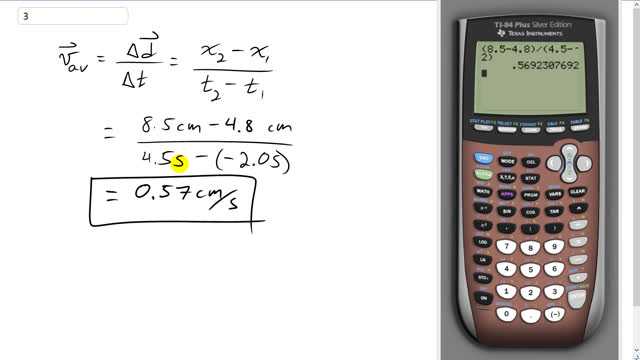
A particle at is at and at is at . What is its average velocity over this time interval? Can you calculate its average speed from these data? Why or why not?
- No.

In order to watch this solution you need to have a subscription.
This is Giancoli Answers with Mr. Dychko. To find the average velocity, we take the change in position of the particle divided by the change in time so that t 2, 4.5 seconds, it's at position positive 8.5 centimeters, and at t 1 which is negative 2.0 seconds, you know, 2 seconds before some arbitrary time 0, it's at position of positive 4.8 centimeters. So we take the difference in these positions divided by the difference in times so this is 8.5 minus 4.8 and divided by 4.5 minus the negative 2.0 and that gives us 0.57 centimeters per second is the average velocity. And for part (b), the answer is no, we cannot calculate the average speed because we don't know the total distance that this particle travels; all we know is the displacement displacement being the vector which is connecting the starting point to the ending point. So it ends up at position 2 here say and it started at position x 1 and the particle may have gone, you know, zigzagging around, back and forth a little bit and finally got to position for started at position 1 and got to position 2 on this zig-zag path in which case, it covered a lot of distance and it wouldn't have to go at a high speed in order to cover that much distance versus some other scenario like this where it took a straight-line path all the way from x 1 to x 2 in which case, you know, the average speed would be the same as average velocity but as soon as it starts to deviate from a straight-line path, as it does in this picture, now the average speed, in this case, is gonna be much greater than the average velocity. So, in any case, we can't tell what the path was; all we know is the starting position and the ending position and so the only thing we can calculate is average velocity.
Why not
Hi joseotilio25, the average speed is distance divided by time. Since the question gives us only displacement, we don't know the total distance. Consider an example to explain the difference between displacement and distance: if a runner travels once around a running track, their displacement will be zero since they return to the same position as they started. There distance, however, would be on a standard track. Average velocity for this runner would be zero since displacement is zero, whereas average speed would be divided by whatever time it took to complete the lap.
Displacement can sometimes have a size equal to distance, which is why the difference between the two can be confusing. The size of the displacement equals distance only when travelling in a straight line in one direction, but otherwise the size of the displacement will always be less than distance.
Hope this helps,
Mr. Dychko